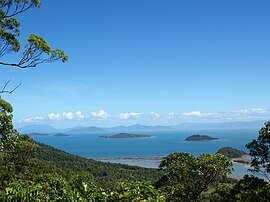Family Islands National Park is an Australian national park comprising a group of continental islands lying a short distance off the coast, about midway between Cairns and Townsville, in Far North Queensland. Most of the area has been designated as part of the national park.
| Family Islands National Park Queensland | |
|---|---|
 View from Dunk Island | |
| Nearest town or city | Tully |
| Coordinates | 17°55′33″S 146°08′07″E / 17.92583°S 146.13528°E |
| Established | 1994 |
| Area | 8.69 km2 (3.4 sq mi) |
| Managing authorities | Queensland Parks and Wildlife Service |
| Website | Family Islands National Park |
| See also | Protected areas of Queensland |
The islands were given their collective name and also English names by Captain Cook when he sailed through the area in 1770. They were part of the mainland until roughly 8,000 years ago when the sea level rose.[1]
The Islands
editThe largest of the Family Islands, their Aboriginal names, and their position in the "family" are:
- Dunk Island (Coonanglebah) – the father
- Richards Island (Bedarra) – the mother
- Wheeler Island (Toolgbar) and Coombe Island (Coomba) – the twins
- Smith Island (Kurrumbah), Bowden Island (Budjoo) and Hudson Island (Coolah) – the triplets.
There are also a number of smaller islands:
- Kumboola, which is connected to Dunk Island on particularly low tides
- Mound Island (Purtaboi), which is protected as a sea bird nesting habitat
- Woln Garin, a small island off Dunk Island's south east corner, known locally as "40ft Rock"
- Battleship Rock (Pee-Rahm-Ah), named because of its distinctive shape when seen from the north
- Thorpe Island (Ti mana), which is privately owned with one residence. This is the only Australian island which is owned freehold.
The European names of the islands reflect the names of the officers on board the survey ship HMS Paluma: Lieutenant G. Richards, commander; Lieutenants Wheeler, Combe and Bowden-Smith; Dr. Thorpe, surgeon; and Mr. Hudson, engineer.[2]
Facilities
editCamp grounds are available on Dunk, Coombe and Wheeler Islands, with permits available from Queensland Parks and Wildlife.[3] Resorts operate on Dunk and Bedarra Islands.
See also
editReferences
edit- ^ "Family Islands National Park: Nature, culture and history". Department of Environment and Resource Management. 3 April 2012. Archived from the original on 3 April 2011. Retrieved 20 August 2012.
- ^ Venn, Linda (2002). Paluma : the first eighty years 1870s-1950s (PDF). Thuringowa City Council. ISBN 978-0-9577305-5-7. Archived (PDF) from the original on 31 October 2019.
- ^ "Family Islands National Park: Camping information". Department of Environment and Resource Management. 3 April 2012. Archived from the original on 21 July 2012. Retrieved 20 August 2012.
